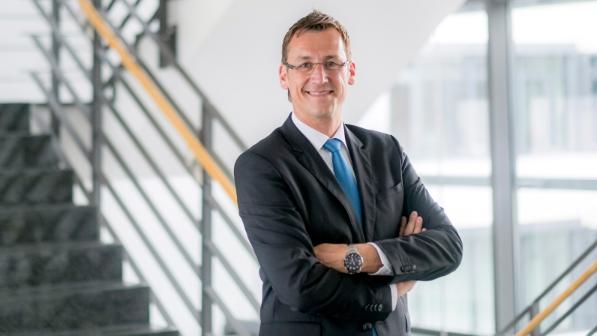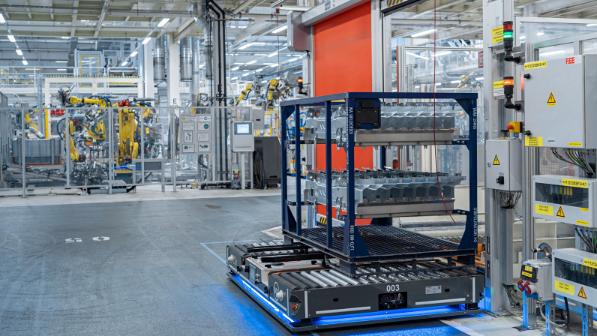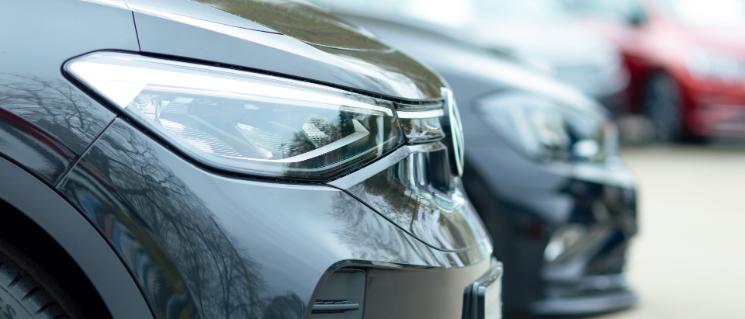The automotive industry invented the modern, just-in-time supply chain. The sector’s largest global players have refined the concept of streamlined, tightly integrated logistics processes to an extraordinary degree. Now, with the aid of emerging digital technologies, the industry is pursuing the next-step change in performance.
For Volkswagen, the biggest carmaking group in the world today, the man with overall responsibility for that transformation within material logistics is Matthias Braun, Head of Digitization and Concept Development at Volkswagen Konzernlogistik, the group’s central supply chain management organization.
Braun’s focus is material logistics: the management of parts between suppliers, VW’s own component plants and its final-assembly facilities, including the flow of material and empty containers. His job, he says, is to “digitize the processes we have within logistics in the Volkswagen world, and to search for new business concepts and business models emerging through digitization.”
That’s a broad scope, and Braun has plenty of territory to cover. Worldwide, Volkswagen has more than 120 plants that build components or complete vehicles. It sources material from roughly 8,500 first-tier suppliers. Within Europe alone, Volkswagen manages around 18,000 truckloads every day, and transports more than 75 million cubic meters of material each year.
To add to the challenge, Volkswagen gives individual plants and business units significant autonomy in the operation of their logistics processes, with the group logistics function responsible for overall strategy, setting standards and assuring synergies. “As you can imagine, we’re talking about 122 plants who are all keen to get the best, newest and hottest stuff in the digital world,” says Braun, adding that it’s “quite tough” to coordinate all of them “so we don’t just build ‘lighthouses’, but also bring efficiency with sustainable solutions and the same methodologies running at all our plants.”

The digital imperative
Digitization, however, isn’t a challenge that Volkswagen logistics can avoid. As the group continues to grow – in size, geographic scope and complexity – the demands placed on its logistics processes are increasing too. “Without digitization, we won’t be able handle that growth,” says Braun. “We need to collaborate differently, and we need to connect differently, otherwise we won’t be able to operate efficiently or in a way that is convenient for our customers.”
Volkswagen has already reached some important milestones on its digital journey. Two years ago, for example, it introduced a standard platform in Europe for communication between plants, suppliers and logistics providers. The system, says Braun, has eliminated swathes of manual work across the logistics network, as supply chain staff and logistics service providers no longer have to rely on emails, faxes or phone calls to confirm the readiness or status of shipments.
Even more significantly, bringing formerly disparate logistics data together in one place has laid the foundations for a host of other valuable improvements. “Creating transparency and closing the loops in our communications with suppliers and service providers is a vital first step,” says Braun. “But the real value comes when you create new applications that can make use of that data.”
Those new applications are arriving now. Some plants in the network, for example, now operate a “critical parts list,” which provides a real-time indication of how long the plant can continue to run using the stocks of components it has on site. If an incoming shipment is delayed, logistics staff can use the list to see if the delay is likely to affect production. That knowledge has the potential to create significant cost savings, allowing Volkswagen to avoid the unnecessary use of expensive expedited freight.
Better data is helping plants to manage inbound deliveries more efficiently. Instead of allocating a fixed arrival slot to trucks a day in advance, they can use a more dynamic system that adjusts slot availability based on the most recent expected arrival time of a shipment. That change means trucks spend less time waiting to unload, improving the utilization of vehicles and their drivers and helping Volkswagen to meet its decarbonization targets.
Volkswagen is also able to use its detailed logistics data at a more strategic level, adds Braun. “From a sustainability perspective, we can optimize our routes and cross-dock structures to improve the utilization of vehicles. We can identify high-runner routes where we can ask our service providers to use LNG trucks. Or we can find opportunities to use combined train-truck transport on major routes.”
Desire for data
The company’s quest to create greater supply chain transparency is an ongoing one, says Braun. “Digitization is not a project; it’s a new way of behaving. There’s no defined end to information interchange. Every time you get new information and make use of it, your confidence grows, and you become more curious.” Work is ongoing to integrate real-time position data from trucks into the system to further refine arrival time estimates. And Braun and his team are already thinking about the next levels of information exchange. “We might like to know about the fuel consumption of our service providers’ trucks so we can better understand the emissions generated by our supply chain,” he says. “Or maybe we could provide our logistics partners with information on our warehouse inventories so they could understand the time remaining before we have a material shortage, and plan their deliveries based on that.”
The digital team is constantly on the lookout for new technologies and solutions that could further streamline processes and improve communication and collaboration across the supply chain. Pilot projects are underway using smart tags to improve the tracking of the millions of reusable racks and containers that shuttle between suppliers and assembly plants, for example.
Volkswagen Konzernlogistik organized a worldwide innovation competition and Innovative Logistics Solution Day earlier this year, inviting logistics providers, established technology companies and startups to present new ideas or collaboration proposals. “We’re not interested in technology for its own sake,” says Braun. “We want every conversation with a potential collaborator to start from the basis of a real problem or pain point in our processes, then we can decide if a particular technology might provide a solution.”
Why go looking for the latest logistics stories and insights when you can have them delivered right to you?
The human factor
Braun notes, however, that there are plenty of other important challenges to greater digitization to be overcome. One of them is the lack of skilled workers. “In logistics, we have a shortage of truck drivers, and we have a shortage of qualified IT people,” he says. “Sometimes it’s hard to bring together the right experts within the key departments of both sides to share data and work with it to create new value.”
Then there’s trust. While digital projects create an endless appetite for data sharing, says Braun, legal and commercial sensitivities place inevitable restrictions on information that can be shared across corporate boundaries.
Finally, there is the need to persuade people that digitization doesn’t represent a threat. “I’m very lucky that the team I’m responsible for is open-minded and curious, but also well connected with the real world,” says Braun. “Our people are not only looking for new concepts, but also for things they can implement to make things better.”

Not everyone in the Volkswagen organization is as naturally enthusiastic or technically savvy, however. To help its whole workforce embrace digitization, Volkswagen Konzernlogistik runs a capability building program called “The Digital View.” Its aim is to make the benefits of new technology clear, beginning at the individual level. “We start by showing people how to use digital tools in their daily working lives, things like using digital note-taking applications,” explains Braun. “Then we go on to look at how digital tools can improve collaboration with colleagues, with things like Skype calls for meetings or SharePoint to make information accessible to everybody.”
A key success factor for the project, says Braun, is that the training is done by Konzernlogistik staff, rather than by external lecturers. “There’s greater trust when you’re learning from a colleague who explains the actual benefits for your daily work,” he notes, adding that once people recognize those benefits, “they’re much more willing to embrace the next level and look for ways to improve processes through digitization.”
Breaking through boundaries
Where will Volkswagen’s digital supply chain transformation lead? Braun is bullish about the potential. In the next five to 10 years, he says, the company will be able to operate a fully digital twin of its entire supply chain, including every supplier, service provider, component, container, truck and rail car in its network. Automation will be commonplace in physical activities like transport, loading and the movement of parts to production lines, as well as in administrative workflows. Roles will change, too, with fewer people involved in repetitive transactional tasks and more in strategic activities such as advanced planning, their decision-making aided by artificial intelligence tools.
Ultimately, digitization could change the way automotive supply chains work, moving the industry from its traditional buyer-supplier relationships to a much more collaborative model. “Boundaries for information will disappear, so that much more information will flow in a safe, secure and legal way through all our organizations,” concludes Braun. “Company borders will disappear, and we will all work in a single ecosystem of information with common responsibilities.” — Jonathan Ward
Published: November 2019
Images: Volkswagen AG, Kai-Uwe Knoth/Volkswagen AG






